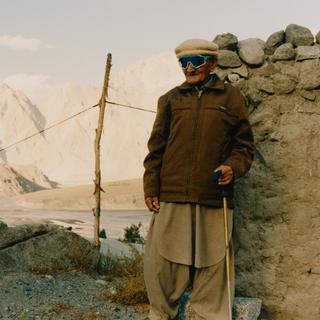


Handing out sunglasses in the Himalayas to protect against the damaging sun
In picturesIn Pakistan's Naltar Valley, the sun's rays are so intense that eight out of 10 people suffer from eye problems. German photographer Cornelius Kaess followed the work of Shades of Love, an NGO that gives sunglasses to these high-altitude inhabitants.
Living at very high altitude exposes you to many dangers: The cold, the lack of oxygen and the intensity of solar radiation, which causes all kinds of eye diseases affecting the cornea, iris, lens, retina and optic nerve. In September 2023, 35-year-old German photographer Cornelius Kaess travelled to Gilgit-Baltistan in northern Pakistan to document the work of Shades of Love, a German NGO that has been collecting new and used sunglasses from all over the world since 2009 for distribution to people living in very high mountain regions.
Kaess's images portray a region of the Himalayas that is among the most militarized in the world, and therefore particularly little-known. It is one of the two administrative areas of Kashmir, along with Azad Kashmir, occupied by Pakistan, just after they were initially devolved to India at the time of partition between the two countries in 1947.
The photos were taken at an altitude of over 4,000 meters in the Naltar Valley, not far from the Afghan corridor that runs along the Chinese border in its western part. Lakes and forests abound, under the imposing gaze of the snow-capped peaks of Chari Khand and Shani Peak (both nearly 5,900 meters), little brothers in the Karakorum range of the famous K2 (8,611 meters), the second highest mountain on the planet after Everest.
Premature cataracts, eye cancer
Ultraviolet radiation is so intense that eight out of 10 people here suffer from eye problems, often before the age of 30. Premature cataracts, eye cancer, loss of vision: In Gilgit-Baltistan, 1.6 million people out of a population of 2 million are thought to be affected. "We know that the amount of UV increases with altitude, at a rate of 4% every 300 meters, and that the combination of altitude and snow from 2,000 meters results in a doubling of the amount of UV compared with sea level," said Niklas Huppmann, co-founder of the NGO. When a person goes blind, their life expectancy drops by a third, and their ability to find work in very rugged terrain drastically diminishes, making them entirely dependent on those around them.
Just before flying to Islamabad and then Gilgit, the regional capital, Kaess dislocated his shoulder at home in Bavaria. So he took lightweight equipment to be able to work with just one hand, in autofocus, exclusively on film. Well-versed in mountain sports, having grown up at the foot of the Alps, he already had a number of high-altitude documentary experiences to his credit, in Nepal, the Andes, Bolivia and Peru.
You have 40% of this article left to read. The rest is for subscribers only.
